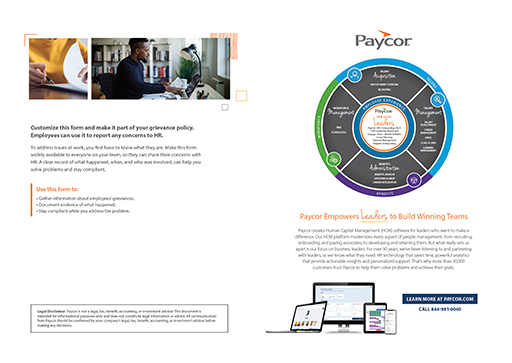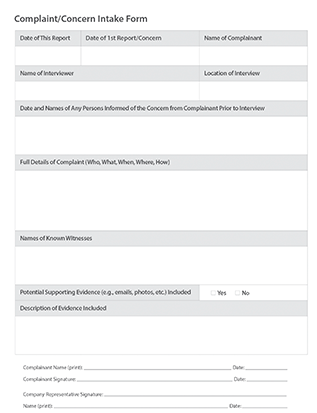How and Why to Create an Employee Grievance Policy
Every workplace has its share of disputes. Whatever your industry or company size, unchecked conflict can lead to serious problems, impacting everything from employee engagement and retention to compliance and revenue. That’s where a strong employee grievance policy comes in.
What is a Grievance Policy?
A grievance policy is a formal procedure that outlines how employees can raise concerns about their work environment and relationships. It should outline the process from start to finish, so workers know exactly how to ask for help when they need it. Having a clear grievance process shows you’re committed to fostering a respectful work environment.
Benefits of a Grievance Policy
A clear, effective grievance policy can:
- Boost engagement: Employees with hidden grievances are absent more often (International Journal of Economics and Business Management). On the other hand, employees who feel supported and psychologically safe, are more likely to engage at work. That leads to retention and productivity.
- Improve communication: A grievance procedure encourages open communication, fostering trust between employees and leaders.
- Minimize legal risks: A fair grievance policy helps you stay compliant with local and federal laws. That could include anything from workplace harassment to potential ADA violations. You’ll boost morale, keep your team safe, and avoid costly legal fees, all in one fell swoop.
- Strengthen company culture: A strong grievance policy shows that your company values employee well-being. That’s just good business. Genuinely caring about team members improves every part of people management, from recruiting to long-term retention.
The Role of Human Resources
Company leaders play a pivotal role in designing and implementing grievance procedures. HR normally takes the lead in this process, working closely with other departments. For example, make sure your legal team reviews your policy before you share it with employees.
HR should set up clear internal procedures for what to do when a team member files a complaint. Having a formal process gives your employees a practical, efficient way to express their concerns. It also helps you identify potential issues quickly, so you can resolve them before they snowball into company-wide problems.
Some grievances – although thankfully not all – turn out to be compliance issues. HR normally handles all things compliance, from ERISA requirements to OSHA regulations. With that expertise, HR leaders are the best people to handle grievance procedures. Just make sure you have the tools you need to track the associated paperwork, so you can guard against potential legal issues.
While you definitely need a grievance policy, you can also take steps to minimize employee complaints. For example, HR can conduct regular, anonymous surveys to get a read on company culture and employee satisfaction. Paycor Pulse Surveys let you gather this information in a psychologically safe way.
How to Craft an Employee Grievance Policy
An effective employee grievance policy should cover both major and minor issues. Make sure you provide clear guidelines about who an employee should approach in different situations. For example, if an employee is being harassed by their direct supervisor, should they talk to that person’s boss, or should they go to HR? Ideally, every business leader should be accountable to at least one of their peers.
Your policy should address as many specific issues as possible, from workplace bullying to discrimination to sexual harassment. Brainstorming this list can also help you plan out future employee training. If some grievances are especially common at your company, your workforce could benefit from learning how to avoid them.
Include your grievance policy in the employee handbook and share it with new hires during the onboarding process. Make sure every new employee signs an acknowledgment form, indicating they’ve received and reviewed the policy. Whenever you update the policy – which you should do regularly – share it with your current team and have them sign a new acknowledgment form. Make sure you keep those documents on file. If your company ever faces a lawsuit or a federal complaint, they can help you stay compliant and avoid fines.
Ask your legal team whether your grievance procedures should describe the consequences of certain actions. For example, what behavior will result in employee suspension? In certain industries, it makes sense for workers to know the answer from the moment they join your company.
What Goes in a Grievance Protocol
When you’re writing the grievance protocol itself, make sure to include:
- Reasons an employee can file a grievance (harassment, bullying, safety concerns, etc.)
- A timeframe for when they should make the complaint
- Who the employee should contact first (about their grievance and how they should be contacted (in person or in writing via a grievance form)
- Who the employee should contact if the initial point of contact is the person their grievance is related to (HR, the person’s supervisor, etc.)
- What type of response they should expect to receive (in-person meeting, mediation, request for more information, etc.)
- Confidentiality protocols
- What steps HR will take in response to receiving a complaint
- An approximate timeframe for how quickly grievances are reviewed (make sure not to overpromise here, or commit to a timeframe for completely resolving the problem)
- How employees can respond when a grievance is made against them
- How to appeal a decision
When someone submits a complaint, HR should remain impartial. Avoid taking sides, asking the complainant exhaustive questions, or challenging their story. Instead, thank them for coming forward and explain that you’ll initiate a fair, impartial process as outlined in your grievance policy.
Never tell a complainant what to expect from this process in advance. That includes telling them whether you’ll take disciplinary action, committing to a firm timeline, or even reassuring them that “everything will be ok.” Instead, share only realistic, factual information, and encourage them to review your complete policy.
How Paycor Helps
Paycor helps business leaders recruit, manage, develop, pay, train, and retain employees. We do that through an integrated suite of HR software, and by providing free resources for HR leaders – like our complaint intake form. Employees can use this document to formally report grievances to HR, so you have a clear record of everything that goes on in your company. Download the template and customize it to meet your team’s needs.











